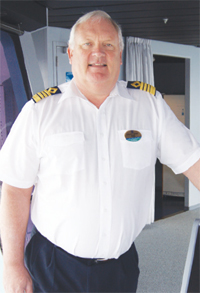Captain Arnolf Fredrik Remo, master of the Southampton-based Royal Caribbean International cruise ship Independence of the Seas (2008/154,407gt), talks to Andrew Cooke about his career at sea.
How and when did your career at sea get under way?
I was born and raised in Ålesund, Norway and come from a family with a long association with ships. From the age of four I loved to sail with my family so, perhaps, it was no surprise when I chose to follow the family tradition. After joining the Norwegian Navy in 1962, I went to the Naval Academy and Captain’s School in my home town. My career began in 1967 on board the 20,000gt bulk-handling ship Havgast.
How has your career developed?
I have been with RCCL for around 35 years and have witnessed the substantial changes and developments in the company. In the early days RCCL had just three ships, so jobs were few. I was promoted to Chief Officer in 1978 and to Staff Captain in 1980. Later, in 1988, I was elected as supervisor for RCCL’s newbuilding projects in St Nazaire, France (Sovereign of the Seas, Monarch of the Seas and Majesty of the Seas). This lasted three years and, upon my return to the sea, I was promoted to Captain on the 1971-built Nordic Prince, and later became Captain of Monarch of the Seas. Between 1995 and 1997 I worked at Royal Caribbean International’s (RCI) Head Office in Miami developing RCI’s Safety and Quality Management.
What was your first RCCL ship?
My wife’s brother, Captain Leif Otto Bang (currently master of Voyager of the Seas), introduced me to Royal Caribbean Cruise Line (RCCL), and in 1976 I was offered a job on RCCL’s Nordic Prince as First Officer.
Of the ships you have served on, do you have a particular favourite other than perhaps Independence of the Seas?
The 2001-built Adventure of the Seas (137,276gt) will always have a special place in my heart. I went to Turku, Finland in April 2001 to oversee her building, and the tragic events of 9/11 happened just prior to the ship’s delivery. I undertook the delivery voyage to New York from Turku in October 2001 and it was very special and emotional to sail the first cruise ship into New York harbour since that day. The arrival of the new ship represented hope for the future while the smoke and damage from Ground Zero was still in evidence. I still feel very proud to have been part of that historic event. RCI invited around 3,600 employees and families of the New York Police and Fire Departments on a free two-day cruise, something I will never forget. The naming ceremony was also unforgettable, with many high-profile people in attendance.
Do you have a particular highlight from your career?
Apart from the events surrounding the delivery of Adventure of the Seas, joining Independence of the Seas in June 2008 was a highlight. I enjoy the challenges of handling such an innovative vessel, as she has so much to offer. As Master, I am also proud to make my team feel personal pride when they go that extra mile and when I see what they achieve. In 2005 I also worked as a Task Captain for the pre-contract evaluation of the new ship design that produced the 225,282gt ships Oasis of the Seas and Allure of the Seas.
Describe an average working day for you onboard.
An average day as a Captain is never routine. I deal with situations as they arise and my day begins between 0400 and 0700. I am on the Bridge to see the ship safely in and out of each port and am on call 24 hours. How many crew work on board and what are their roles?The ship is divided into the Marine, Engine and Hotel Departments. Meetings take place within the various departments on a daily basis to deal with everything concerning the safety and well-being of the guests. There are 1,350 crew and everybody knows their role.
What is the most useful innovation you have seen introduced duringyour time at sea?
Independence of the Seas is a hi-tech ship and a dream for me to operate. We have the best equipment and a well-educated crew. It is difficult to choose just oneinnovation, as all of today’s bridge equipment enhances safetyand navigation.


